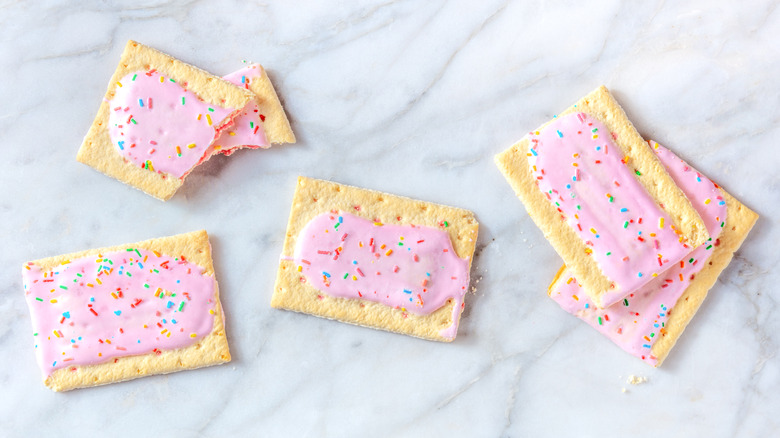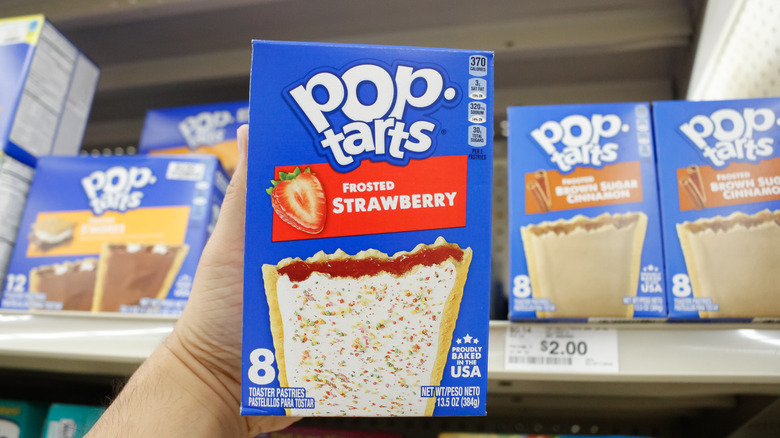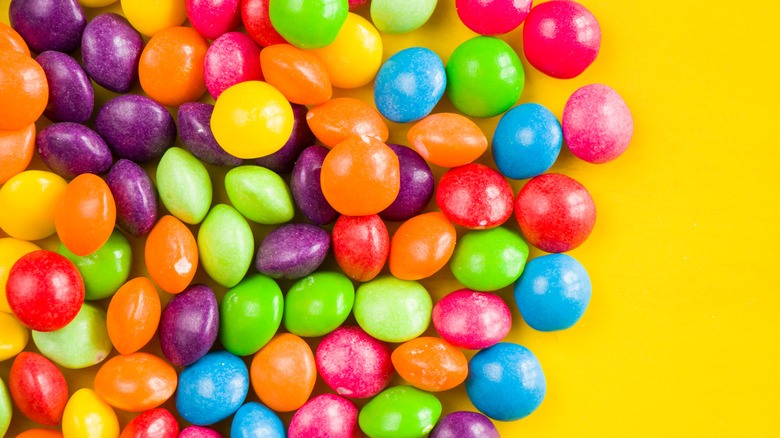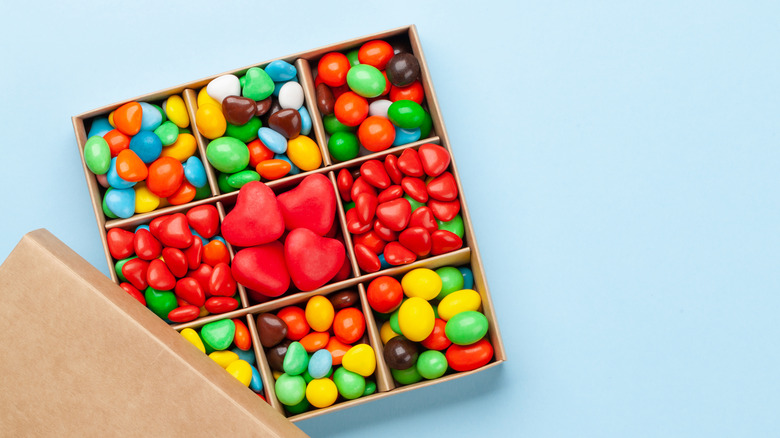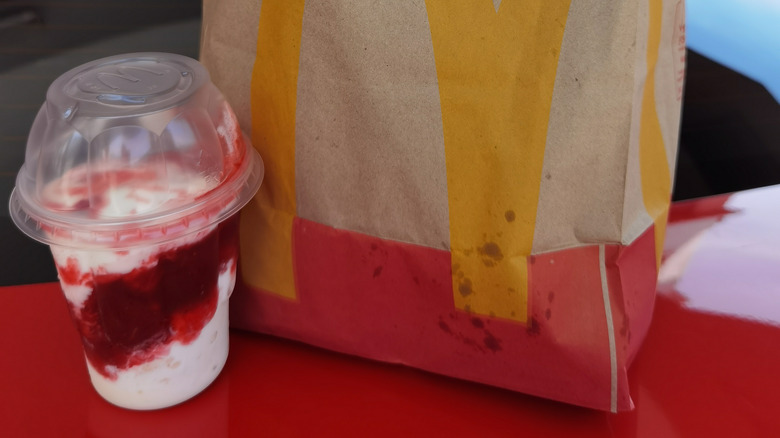The Surprising Reason Pop-Tarts Are Banned In Other Countries
Compared to other countries, the U.S. has notoriously relaxed regulations regarding food additives. Things like flame retardants and carcinogens are federally allowed to be added to our food in small amounts and still be considered safe for consumption (via WebMD). In other countries, however, this isn't the case. The Daily Meal compiled an exhaustive list of specific ingredients and additives that are banned in some places, and, forewarning, it's a little freaky to read.
Ever heard of the recombinant bovine growth hormone (rBGH)? Well, it's a man-made hormone given to cows to make them produce more milk (via Center for Food Safety). In those countries where the hormone is deemed unsafe, you won't find milk produced by cows treated with rBGH at their supermarkets. The same goes for the brominated vegetable oil (BVO) additive found in sodas and sports drinks. According to Stacker, popular products permitted in the U.S., like Lucky Charms, Swiss Rolls, Mountain Dew, and even Pop-Tarts, are actually illegal or come with a warning label in other countries. Yes, you read that correctly. The much-loved breakfast food is partially banned in the European Union. But why?
Pop-Tarts contain added dyes
The good news is that Pop-Tarts don't contain any flame retardants, carcinogens, or other especially harmful chemicals that some of the other listed foods have in their ingredients list. Now for the not-so-good: Pop-Tarts aren't allowed in certain European countries due to the inclusion of food dyes Yellow 5, Yellow 6, and Red 40 (via Stacker).
The use of these dyes in food is banned in Finland, France, Austria, Norway, and the U.K., according to AARP. The Environmental Working Group published a full list of different additives that are found in foods in the United States and the effects that come from eating them. The list can be found here, and is full of useful knowledge if you're concerned about consuming certain chemicals and additives. We totally understand that these frosted breakfast favorites are incredibly delicious and convenient, but if you're concerned about any health issues that could arise from consuming these dyes, it's best to check the label and possibly eliminate them from your pantry.
Why are the dyes banned in some countries?
While we may not think that consuming food dyes is a huge issue here in the United States, there's actually a lot of research backing the negative effects that can come from consuming them too often (via Slate). The Center for Science in the Public Interest has published a few studies regarding the safety of the consumption of these dyes and the potential risks they may pose to people, especially children.
A 2007 study published in the Lancet changed things for Europe. Through a controlled trial, scientists evaluated six dyes, two of which are found in many Pop-Tarts (Red 40 and Yellow 5). They concluded that the dyes have adverse effects on the behavior of young children and infants. As a result, in 2010, the European Parliament mandated that foods containing any of the six artificial dyes carry a warning label, and for food created specifically for kids, the use of food dyes is outright banned. Many foods that children eat contain these dyes, like sugary drinks, candy, and cereals.
What are the effects of consuming food dyes?
The Center for Science in the Public Interest has published a few studies regarding the safety of the consumption of these food dyes and the potential adverse risks they may pose to people, especially children. This report, published in 2010, found that "that many of the nine currently approved dyes raise health concerns." The dyes, which were originally synthesized from coal tar, but are now made instead with petroleum, raise concerns like cancer, allergic reactions, and hyperactivity and other behavioral issues in children. For these reasons, some of the dyes are not allowed in Britain and require a warning notice on packages that contain them in the European Union.
People have been consuming these food additives and dyes for years, and most do not experience any effects from them (not that we notice, anyway). But what sort of things might happen if we continue to eat foods with added chemicals? Healthline writes that "In multiple studies, Yellow 5 — also known as tartrazine — has been shown to cause hives and asthma symptoms." Other findings reported that people who are allergic to aspirin appear more effected by the food dye. If you find that you have symptoms of allergies, removing artificial food dyes from your diet may be a good idea.
Food dye consumption is increasing in the US, decreasing in other countries
According to an article published in Environmental Health Perspective in 2010, people in the United States consume five times as much food dye than they did in 1955, and the numbers were likely to continue increasing. They wrote that, according to the FDA, "ingestion of free benzidine raises the cancer risk to just under the 'concern' threshold." Benzidine is a known carcinogen that's permitted in dyes — including Pop-Tarts' Red 40, Yellow 5, and Yellow 6 – as long as it's in low (and presumably safe) amounts.
Other countries are finding new ways to color their food, such as Fanta orange soda in the U.K., which uses pumpkin and carrot extracts. The U.S. version still contains Yellow 6 and Red 40 (via Fanta). Similarly, McDonald's strawberry sundaes use (surprise!) strawberries to get their signature red color in the U.K., while Red 40 is still used in the U.S. It seems that there are plenty of solutions for food dyes that are likely safer for consumption, and other countries are already taking the steps necessary to reduce added chemicals in their food. We can hope that the U.S. starts moving in a similar direction soon!
